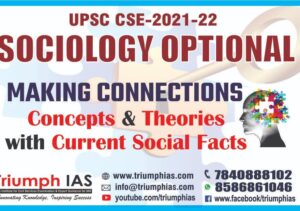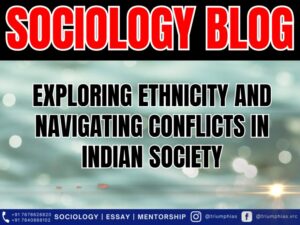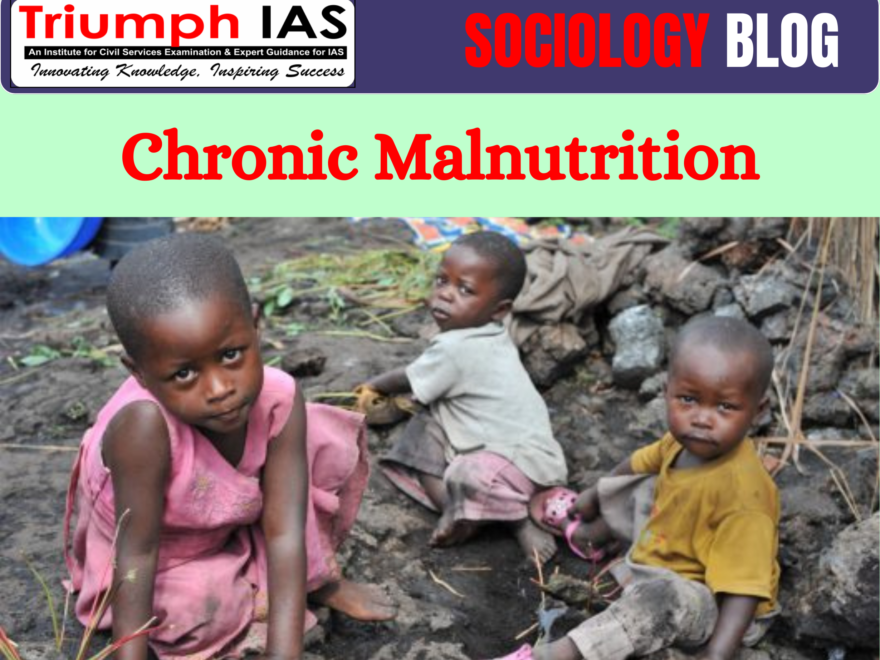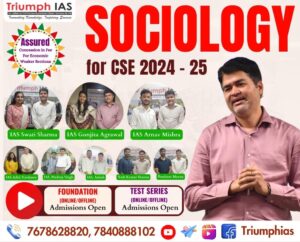Chronic Malnutrition
Relevant for Sociology Optional for Civil Service Examination.
Sociology Paper -2
Unit 3 : Social Change in India : Population Dynamics
Chronic Malnutrition
- Chronic malnutrition, also known as chronic under nutrition, is a condition characterized by long-term deficiencies in essential nutrients, vitamins, and minerals in an individual’s diet. This condition often occurs when a person’s intake of necessary nutrients consistently falls below the body’s requirements for growth, development, and overall health.
- Chronic malnutrition is particularly concerning in children, as it can lead to stunted growth and impaired cognitive development. It can also weaken the immune system, making individuals more susceptible to infections and other health problems. In adults, chronic malnutrition can result in reduced productivity, increased vulnerability to diseases, and negative impacts on overall well-being.
- Social determinants of malnutrition refer to the broader social, economic, and cultural factors that influence an individual’s nutritional status. These determinants play a significant role in shaping access to nutritious food, healthcare, and overall well-being. Some key social determinants of malnutrition include:
- Income and Poverty: Low income limits the ability to afford nutritious foods, leading to inadequate dietary intake and increased vulnerability to malnutrition. Having less nutritious food and poor dietary choice is sometimes related to culture of poverty.
- Education: Limited education can result in a lack of knowledge about proper nutrition, feeding practices, and health-seeking behaviours. Here lack of informational capital transforms into nutritional deficiency.
- Gender Inequality: Women and girls often have restricted access to food and resources as a manifestation of patriarchal control on entitlement over food impacting their nutritional status. Gender norms can influence dietary choices and distribution within households.
- Social Inequities: Discrimination based on caste, ethnicity, race, or other social factors can result in differential access to resources and nutrition-related services.
- Access to Clean Water and Sanitation: Poor sanitation and lack of clean water can contribute to infections and diseases that further compromise nutritional health.
- Healthcare Services: Limited access to healthcare, especially in rural areas, can result in inadequate prenatal and postnatal care, affecting maternal and child nutrition. Here sometimes lack of efficiency of legal bureaucratic structure to provide efficient water supply can be seen of reasons. The social contract is not uphold by legal rational authority in real sense.
- Food Environment: Availability of affordable and nutritious foods within communities plays a crucial role in shaping dietary choices.
- Cultural Practices: Cultural beliefs and traditions can influence dietary habits, food choices, and feeding practices, impacting nutritional intake. Some cultures even resist vaccines and fortified foods., Another aspect of Culturally rooted norms where are burdened with fasting and duty bound to have meal in last are also some factors which causes malnutrition in females.
- Migration and Urbanization: Rapid urbanization and migration can disrupt traditional food systems and dietary patterns.
- Food Security: The ability to consistently access sufficient, safe, and nutritious food is a fundamental determinant of nutritional status.
- Employment Opportunities: Unemployment or underemployment can hinder the ability to afford and access nutritious foods.
- Policy and Government Initiatives: Government policies related to agriculture, nutrition, and healthcare can significantly impact access to nutritious food and healthcare services. Government push to GREEN REVOLUTION has impacted the dietary habits of people. Millets, pulses etc. have been replaced by rice and wheat and food pallet has become homogenous and less nutritious.
Solution of malnutrition :
There can be three approaches to tackle issue of malnutrition
- Behavioral Approach: this approach focus on the idea that individual choices and behavior in terms of lifestyle and diet have greatest impact on their health. Hence according to this approach focus should be on
- Nutrition Education: Raise awareness about the importance of a balanced diet and the nutritional needs of different age groups and Educate caregivers, parents, and communities on preparing nutritious meals using locally available ingredients.
- Breastfeeding Promotion:
- Encourage exclusive breastfeeding for the first six months of life and continued breastfeeding alongside complementary foods.
- Offer support and facilities for breastfeeding mothers in workplaces, communities, and healthcare settings.
The network of grass root workers like ASHA workers and Aaganwadi workers can play the part of mobilising the motivation and reduce informational deficiency. This can nudge behavioural changes in people.
- Neo materialist approach: According to this approach malnutrition can be linked to economic factors and to wider social structure. And intervention on these levels can help us to solve the problem.
- Access to Nutritious Food:
-
- Improve agricultural productivity and diversify crops to ensure a steady supply of nutritious foods.
- Promote home gardening and community farming to increase access to fresh fruits and vegetables.
- Support local food markets to provide affordable and varied food options
- Supplementation and Fortification:
-
- Provide vitamin and mineral supplements to populations at risk of deficiencies, such as pregnant women and children.
- Fortify staple foods like flour, salt, and cooking oil with essential nutrients.
- Healthcare Services:
-
- Strengthen healthcare systems to ensure early detection and treatment of malnutrition-related illnesses.
- Provide access to prenatal care, postnatal care, and child health services.
- Clean Water and Sanitation:
-
- Improve access to clean drinking water and sanitation facilities to prevent waterborne diseases that exacerbate malnutrition.
- Psycho social approach: according to this approach apart from economic and social structures, the stress of living in unequal society and being aware about impacts the nutritional and health prospects of individual.
- Social Safety Nets:
-
- Implement programs that provide direct food assistance or cash transfers to vulnerable populations.
- Establish school feeding programs to ensure children receive nutritious meals during school hours.
- Empowerment of Women:
-
- Empower women through education and economic opportunities, as their well-being is closely linked to family nutrition.
- Community Engagement: Involve local communities in designing and implementing solutions, ensuring culturally relevant and sustainable interventions.
Conclusion
India is witnessing its demographic dividend and malnutrition hampers its prospects og growth. Totackle the issue of malnutrition an combined tailored method based on all three approaches will help in long run. Parsons idea of sick role which focus on both rights and obligations of malnourished people can guide the policy measures.. Parsons highlighted the social nature of illness and how it affects individuals’ behavior and interactions within a society. The sick role involves both rights and obligations, creating a framework for understanding how society responds to illness. This perspective underscores the interplay between health, social expectations, and medical intervention, shedding light on the complexities of health-related experiences.
Reference: Static Portion
Related Blogs…
 |
 |
Frequently Asked Questions:
1. Question: Define the term “ethnic movement” and provide an example from India.
Answer: An ethnic movement refers to a collective effort by a group sharing common cultural, linguistic, or religious traits, seeking to assert their identity and rights; an example from India is the Khalistan Movement in Punjab.
2. Question: Identify the main objectives behind the Gorkhaland ethnic movement.
Answer: The Gorkhaland ethnic movement primarily seeks to establish a separate state for India’s Nepali-speaking population in the Darjeeling region, advocating for linguistic and cultural recognition and political autonomy.
3. Question: What was the Operation Blue Star, and which ethnic movement was it related to?
Answer: Operation Blue Star was a military action in 1984, aiming to remove Sikh militants hiding in the Golden Temple in Amritsar; it is related to the Khalistan movement, which sought a separate Sikh country.
4. Question: Mention a critical factor that triggered the emergence of ethnic movements in India, as discussed by Dipankar Gupta.
Answer: Dipankar Gupta emphasized that ethnicity is fundamentally a political process, wherein caste and religion, the key components of identity formation, are politicized by leaders for vested interests.
5. Question: What were the primary reasons for the Assam Ethnicity conflicts involving Bodo tribals and Bengali Muslim settlers?
Answer: The Assam Ethnicity conflicts primarily stemmed from issues related to immigration, land rights, and resource allocation, leading to clashes, riots, and evolving relationships among indigenous communities to address challenges.
6. Question: Briefly describe the role of the Dravidian Movement in terms of caste and societal structure.
Answer: The Dravidian Movement, led notably by E.V. Ramasamy, aimed to establish an egalitarian society, focusing on anti-Brahmanism and advocating for equal rights for backward castes, while also introducing reforms like self-respect marriages.
7. Question: Name the prominent ethnic movements in North-East India and specify one common objective.
Answer: Prominent ethnic movements in North-East India include the Nagas’ and Mizos’ struggles; a common objective was to gain autonomy and recognition for their distinct tribal identities and cultural uniqueness.
8. Question: What is the key argument of Gail Omveldt regarding traditional Indian society and multiculturalism?
Answer: Gail Omveldt opposed romanticizing traditional Indian society, arguing that hierarchy has always dominated it and dismissing the notion that multiculturalism is an intrinsic feature of Indian society as a myth.
9. Question: Briefly explain the social hierarchy factor as a contributing element to ethnic movements as suggested by Olzak.
Answer: Olzak suggests that the construction of hierarchies among ethnic communities, which often leads to the suppression of one group by another, is a key factor that can instigate social and ethnic movements.
10. Question: Identify one consequence of the unequal economic development factor within the context of ethnic movements in India.
Answer: One consequence of unequal economic development is the marginalization and underdevelopment of certain groups, leading to feelings of alienation and sometimes initiating ethnic movements as these groups strive for equality and recognition.
GS Related Practices Questions…
To master these intricacies and fare well in the Sociology Optional Syllabus, aspiring sociologists might benefit from guidance by the Best Sociology Optional Teacher and participation in the Best Sociology Optional Coaching. These avenues provide comprehensive assistance, ensuring a solid understanding of sociology’s diverse methodologies and techniques.
META TAGS:
Ethnic Movements, ethnic movements in india, ethnic movement in sociology, Punjab Movement, North-East Ethnic Movements, Gorkhaland Movement, Dravidian Movement, Assam Ethnicity, Ethnic Conflicts, Sociopolitical Impact, India, Ethnic Consciousness, Ethnic Rights, Political Crisis, Economic Development, Cultural Disparities, Khalistan Movement, Nagaland, Mizoram, Multiculturalism, Political Economy, Identity Formation, Social Hierarchies, Bodo Tribals, Bengali Muslim Settlers, Anti-Sikh Riots, Operation Blue Star, Unequal Development, Ethnic Violence, Political Mobilization

Why Vikash Ranjan’s Classes for Sociology?
Proper guidance and assistance are required to learn the skill of interlinking current happenings with the conventional topics. VIKASH RANJAN SIR at TRIUMPH IAS guides students according to the Recent Trends of UPSC, making him the Best Sociology Teacher for Sociology Optional UPSC.
At Triumph IAS, the Best Sociology Optional Coaching platform, we not only provide the best study material and applied classes for Sociology for IAS but also conduct regular assignments and class tests to assess candidates’ writing skills and understanding of the subject.
Choose The Best Sociology Optional Teacher for IAS Preparation?
At the beginning of the journey for Civil Services Examination preparation, many students face a pivotal decision – selecting their optional subject. Questions such as “which optional subject is the best?” and “which optional subject is the most scoring?” frequently come to mind. Choosing the right optional subject, like choosing the best sociology optional teacher, is a subjective yet vital step that requires a thoughtful decision based on facts. A misstep in this crucial decision can indeed prove disastrous.
Ever since the exam pattern was revamped in 2013, the UPSC has eliminated the need for a second optional subject. Now, candidates have to choose only one optional subject for the UPSC Mains, which has two papers of 250 marks each. One of the compelling choices for many has been the sociology optional. However, it’s strongly advised to decide on your optional subject for mains well ahead of time to get sufficient time to complete the syllabus. After all, most students score similarly in General Studies Papers; it’s the score in the optional subject & essay that contributes significantly to the final selection.
“A sound strategy does not rely solely on the popular
Opinion of toppers or famous YouTubers cum teachers.”
It requires understanding one’s ability, interest, and the relevance of the subject, not just for the exam but also for life in general. Hence, when selecting the best sociology teacher, one must consider the usefulness of sociology optional coaching in General Studies, Essay, and Personality Test.
The choice of the optional subject should be based on objective criteria, such as the nature, scope, and size of the syllabus, uniformity and stability in the question pattern, relevance of the syllabic content in daily life in society, and the availability of study material and guidance. For example, choosing the best sociology optional coaching can ensure access to top-quality study materials and experienced teachers. Always remember, the approach of the UPSC optional subject differs from your academic studies of subjects. Therefore, before settling for sociology optional, you need to analyze the syllabus, previous years’ pattern, subject requirements (be it ideal, visionary, numerical, conceptual theoretical), and your comfort level with the subject.
This decision marks a critical point in your UPSC – CSE journey, potentially determining your success in a career in IAS/Civil Services. Therefore, it’s crucial to choose wisely, whether it’s the optional subject or the best sociology optional teacher. Always base your decision on accurate facts, and never let your emotional biases guide your choices. After all, the search for the best sociology optional coaching is about finding the perfect fit for your unique academic needs and aspirations.
To master these intricacies and fare well in the Sociology Optional Syllabus, aspiring sociologists might benefit from guidance by the Best Sociology Optional Teacher and participation in the Best Sociology Optional Coaching. These avenues provide comprehensive assistance, ensuring a solid understanding of sociology’s diverse methodologies and techniques. Sociology, Social theory, Best Sociology Optional Teacher, Best Sociology Optional Coaching, Sociology Optional Syllabus.
Best Sociology Optional Teacher, Sociology Syllabus, Sociology Optional, Sociology Optional Coaching, Best Sociology Optional Coaching, Best Sociology Teacher, Sociology Course, Sociology Teacher, Sociology Foundation, Sociology Foundation Course, Sociology Optional UPSC, Sociology for IAS,
Follow us :
🔎 https://www.instagram.com/triumphias
🔎https://www.youtube.com/c/TriumphIAS
🔎https://t.me/VikashRanjanSociology
Find More Blogs…
| Compare and contrast Karl Marx’s and Max weber’s | Karl Marx- Historical Materialism |
| Talcott Parsons : Social system | Scope of the subject and comparison with other social sciences |
KEYWORD: Chronic Malnutrition, Chronic Malnutrition, Chronic Malnutrition, Chronic Malnutrition, Chronic Malnutrition, Chronic Malnutrition, Chronic Malnutrition, Chronic Malnutrition, Chronic Malnutrition, Chronic Malnutrition, Chronic Malnutrition, Chronic Malnutrition, Chronic Malnutrition, Chronic Malnutrition, Chronic Malnutrition, Chronic Malnutrition, Chronic Malnutrition, Chronic Malnutrition, Chronic Malnutrition, Chronic Malnutrition, Chronic Malnutrition


